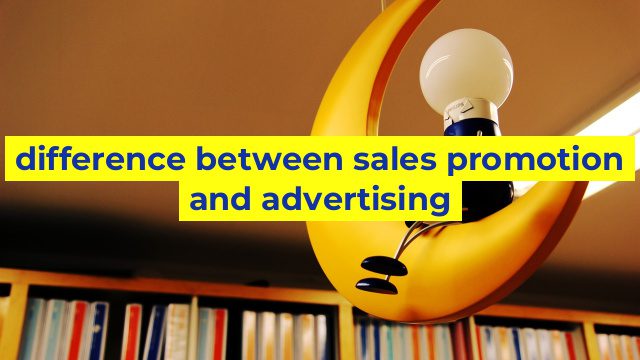The Difference between Sales Promotion and Advertising
Introduction
In the world of marketing, sales promotion and advertising are two essential elements used by businesses to increase sales, attract new customers, and maintain existing ones. Although both strategies aim to promote a product or service, they differ in terms of their objectives, methods, and outcomes. In this article, we will explore the differences between sales promotion and advertising and why they are important for businesses.
Sales Promotion
Sales promotion is a short-term marketing tactic that aims to boost sales and promote a product or service by offering incentives or rewards to customers. In other words, sales promotion offers customers a reason to buy a product or service right now. Common examples of sales promotions include discounts, coupons, free trials, contests, and loyalty programs.
The main objective of sales promotion is to persuade customers to buy a particular product or service by providing them with an added value that they cannot get elsewhere. This can be achieved by highlighting the benefits of the product or service, offering a limited-time deal, or creating a sense of urgency.
Advertising
Advertising is a long-term marketing tactic that aims to create brand awareness, build customer loyalty, and influence customer behavior by communicating a brand’s message to its target audience. Advertising is a more general approach compared to sales promotion, as it seeks to build a relationship between a brand and its customers over time.
Advertising can take many forms such as print, TV, radio, online ads, billboards, and social media. The main objective of advertising is to create a positive image of the brand in the minds of customers by creating a consistent message that resonates with them. By doing this, businesses can attract new customers and retain existing ones, as well as increase sales in the long run.
The Differences
The main difference between sales promotion and advertising is the time frame and the objective of each strategy. Sales promotion is a short-term tactic designed to increase sales within a specific period of time by offering incentives to customers. Advertising is a long-term strategy designed to create a positive image of the brand and influence customer behavior over time.
In terms of the methods used, sales promotion is more focused on creating a sense of urgency and providing added value to customers. Advertising, on the other hand, is more focused on building a relationship with the target audience through consistent messaging and brand awareness.
Conclusion
In summary, both sales promotion and advertising are essential elements of a successful marketing strategy. While they share some similarities, they differ in terms of objectives, time frame, and methods used. Knowing the difference between sales promotion and advertising can help businesses choose the most effective approach to reach their target audience and achieve their marketing goals.
Table difference between sales promotion and advertising
| Sales Promotion | Advertising | |
|---|---|---|
| Definition | Short-term incentives to encourage immediate purchase or sale of a product or service | Communication of information about a product or service to a target audience with the intent to persuade them to purchase or use it |
| Objective | To increase short-term sales or encourage repeat purchases | To create brand awareness, generate interest, and establish a long-term relationship with the target audience |
| Duration | Short-term, usually for a limited period | Long-term, ongoing |
| Target Audience | Existing customers, potential customers, distributors or sales force | General public or a specific target audience based on demographics or psychographics |
| Communication Media | Point-of-purchase displays, coupons, rebates, samples, contests, sweepstakes, loyalty programs | Television, radio, print, online, outdoor, social media |
| Message | Emphasizes the benefits of immediate action, offers a deal or incentive, creates urgency to buy | Creates brand awareness, emphasizes product features, appeals to emotions or rational thinking, establishes a unique selling proposition |
| Cost | Relatively low cost compared to advertising | High cost, especially for television and print advertising |
